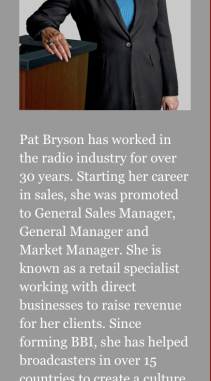
Selling Radio Direct with Pat Bryson
Discussion has been ongoing for years about whether real, live salespeople will be replaced by mechanized buying systems. Some of those systems are in place, producing some sort of results.
Human nature being what it is, a purchase will not take place until the buyer believes that their opportunity for reward is greater than their risk. And that’s where real, live salespeople enter the sales process. Our job with our clients is to reduce risk factors and create value in our campaigns. Other than offering a cheap price, this is something mechanised buying services have a hard time doing.
How do we do this? In our presentation
We can reduce risk by adding several sections to our presentations. Testimonials, stories we tell about other successful clients, are golden. Do you have a bank of success stories? Success letters? If not, this should be a priority as we start 2022. Refresh your testimonial file. Every time a client tells you something great about their results, ask for a letter. If they don’t have time to write it, offer to write it yourself, then have them approve it and put it on their letterhead. When showing it to a client, TELL them the story first. Then give them the written proof. Your stories can be much more elaborate than the written page.
My clients also use what we call a “logo page”. This page is full of logos of businesses who advertise with us. It’s an impressive group of advertisers.
It says to the prospect: “you will be in good company when you advertise with us. Here are some of the businesses who have had great success using us.”
Some of my clients also create a “team page.” This page lists internal people at the station who “touch” a client’s order as it passes through our system. It might include the General Manager, Sales Manager, Salesperson, Traffic Director, Production Director, Copywriter, Business Manager, Program Director. You give contact information for each. Here’s how you use it to assure the prospect:
“When you become a client of XXXX, you have a team assigned to your account. I will be your primary contact, but in case I might be on holiday or on a sick day and you need something immediately, we want you to know whom to call.” Then you walk the prospect through the people. This gives them comfort. It also works well when you are a new salesperson without much experience. You are asking for thousands of dollars and the prospect is wondering if you know what you are doing.
If you are new in the job you can say to the prospect: “As you know, I am new. But your team has decades of experience. I have consulted with them in putting together your campaign.”
Using these risk-reducing elements will help you to close more agreements.
Stacking the value involves linking WHAT you are presenting to WHY you are presenting this particular campaign. What are the benefits to this client? Can you explain WHY you have scheduled the messages the way you have? Campaigns are created based on how the mind learns. We don’t just make schedules up. We create them based on the goals and objectives of the client and the scientific principles that facilitate learning. Advertising is education.
When next you present, double-check that you have provided enough relevant value and have risk-reducing elements in your solution. Higher revenue awaits!
